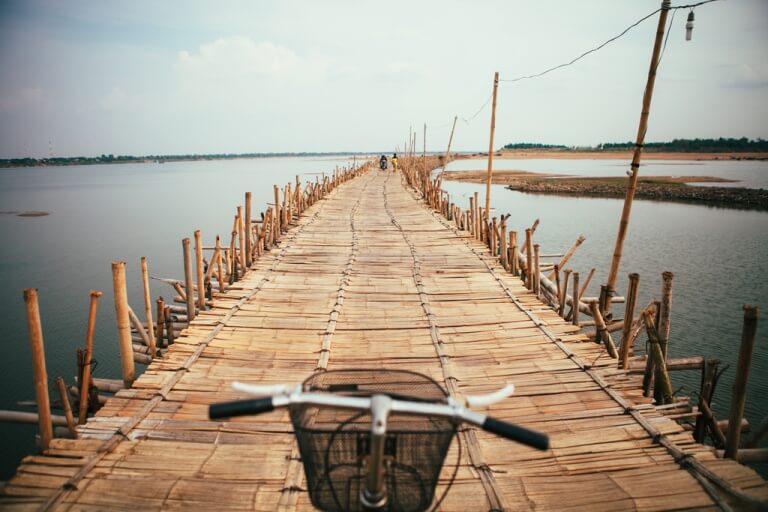On the small island of Koh Paen, completely surrounded by Cambodian terrain, you can still breathe the rural life of this Southeast Asian country. Above the waters of the Mekong River, which flows through six countries, a bridge made entirely of bamboo rocks. With a length of more than a kilometer, this footbridge formed by 50,000 bamboo canes and it is rebuilt every year. Before the rainy season starts (from May to November), the villagers dismantle the bridge manually and store the bamboo material in front of the river floods. The continued construction and dismantling of this historic viaduct has been carried out every year for decades, paralyzing itself only in some periods during the Cambodian Civil War, a conflict that occurred between 1967 and 1975.
The Koh Paen bamboo bridge, marked by tradition, is a symbol that reflects the changing landscape of Cambodia. Representing the tensions between the old and the new, this platform has attracted the attention of tourists who come to the island because of its natural environment and colorful houses. However, despite its popularity, the local practice of “doing and undoing” this step could disappear. In 2017, the Cambodian government had built another bridge, this time using cement, upstream. This permanent construction has caused fears that this unique and complex bamboo framework disappears and with it, the local tradition that sustains it.
This spectacular bridge, which connects the Koh Paen Island with the continental margin of Kampong Cham, presents a complex construction process. Dozens of men from neighboring villages rebuild the catwalk in record time of one month. First of all, the bamboo poles are stuck firmly in the river stream and then a layer of reeds is added horizontally forming the surface. Finally, a large number of posts or poles are placed at different angles completing the construction. These posts are reinforced only with braided wires that act as cable ties.
This walkway is not only a path for tourists and locals, but its structure is strong enough to support the weight of cars, motorcycles and even “tuk-tuks” that cross the bridge every day. The thousands and thousands of bamboo grooves that characterize the surface of this bridge make the journey hectic and slippery due to its unevenness. At night, small light bulbs hung on the poles illuminate the afternoons and the hours before dawn. In the rainy season, when the bridge is not up, a ferry is responsible for taking the inhabitants to the other side of the river.
A paradise connected by the Koh Paen bridge
This pure work of engineering not only deserves a visit for its spectacular, but for the island that houses it. Unmeasured and full of flora, the tiny island of Koh Paen is a veritable scene of rural life in Cambodia. At the end of the bridge, there is the commune of “Kaoh Mitt”. The most characteristic of this small town are the colorful doors that adorn each house. Even the most humble homes stand out for the timid details of flowers on their facades and their well-tended gardens.
The landscape of this little natural paradise does not disappoint either. Its bamboo forests and rows of banana trees lead to extensive rice fields, which surround the extreme north of the island. A natural beauty that can be seen from the longest and “changing” bamboo bridge in the world.
image source: Flickr

